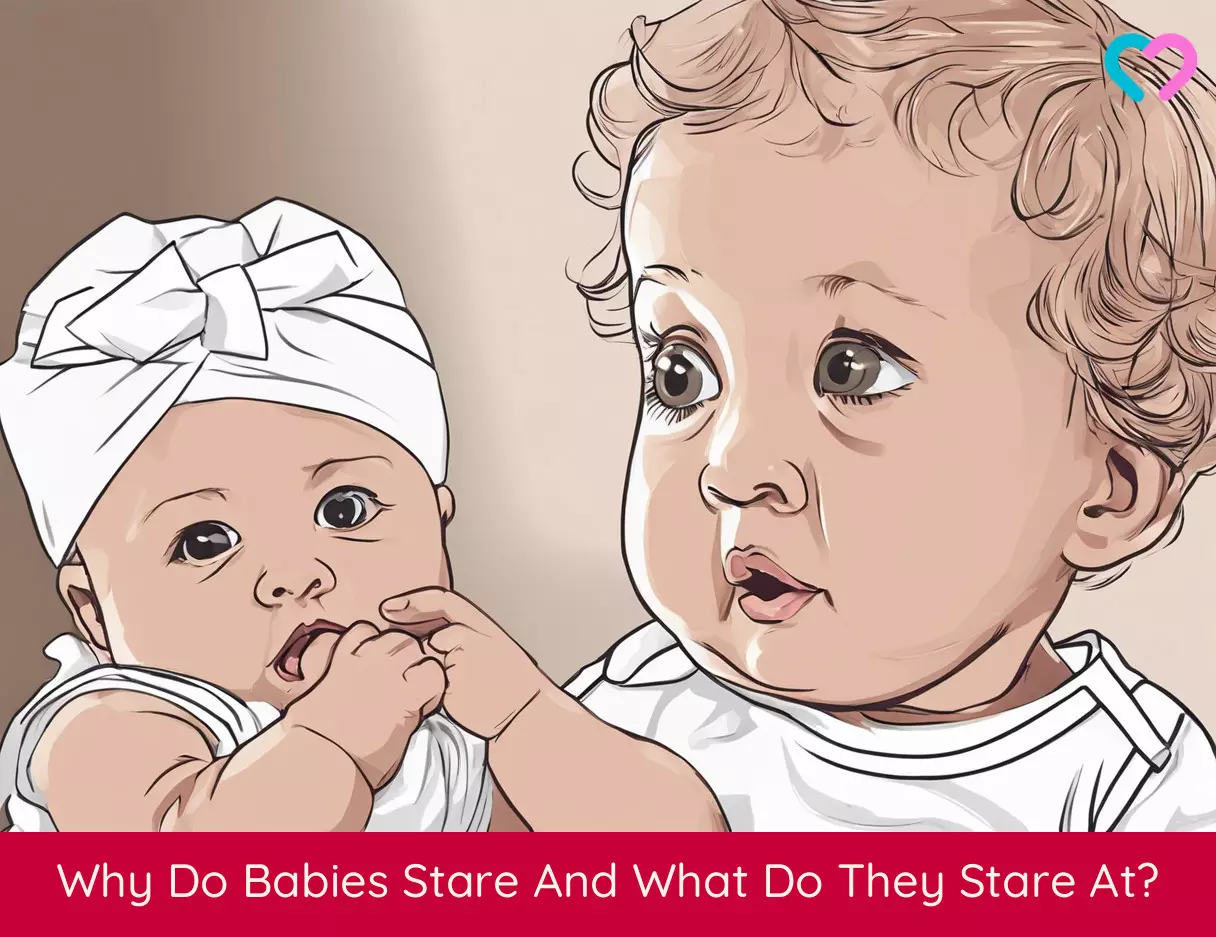
Image: Shutterstock

Many new parents begin to notice their infant staring at particular people randomly, which may lead them to think, “why do babies stare?” Although this staring behavior can be concerning, it is not worrisome.
Most babies feel curious about people and stare at them when they get to know them. Sometimes, they may be attracted to a person’s eyeglasses or bushy beard and stare at them out of fascination. In addition, some babies may stare at objects, ceilings, and walls, indicating that their vision is developing on the right track.
Read on to understand why babies stare so intently and when you should be concerned about it.
Key Pointers
- Babies stare at moving objects, ceiling fans, attractive faces, and contrast colors out of curiosity and is part of their visual development.
- As they age, babies develop their vision and begin to focus on, track, and recognize objects.
- If a baby’s eyes appear crossed, have white pupils, or they don’t recognize people by two months, consult a pediatrician.
Understanding A Baby’s Vision
In order to know why babies stare, we first need to understand their vision (1) (2). Below are some salient points about a baby’s developing eyes and vision.
- Newborns are quite sensitive to light at birth. Their pupils become very small when exposed to bright light.
- Objects located to the baby’s side are more easily visible to them through their peripheral or side vision. However, they cannot see far away things clearly as their central vision is still developing.
- For the first 2 months babies’ eyes may appear crossed or may seem to wander to the sides. It is usually normal but if one of the eyes is constantly turned inward or outward (towards the nose or away from the nose respectively) consult a pediatrician.
- By three months of age a baby can best focus on objects that are eight to 12 inches away. They can look into their mom’s or dad’s eyes if they are close to them. Anything farther than that would be out of focus and blurred.
 Did you know?
Did you know?- At around five months is when babies can see clearly. They develop the ability to see how far an object is from them (depth perception). They get better at reaching out to objects then. They may have color vision but it is still developing.
Thus, babies are more attracted to human faces, followed by bright colors, images with contrasting colors or patterns, and moving objects.
Why Do Babies Stare?
After understanding a baby’s vision, it is evident that babies stare at objects and people when these are of interest to them. A baby’s vision is not fully developed, and they are mostly attracted to light, moving objects, such as ceiling fans, and objects with contrasting colors (3).
By the age of six to eight weeks, as their vision is better developed than before, they would often focus on human faces and indulge in visual exploration and learning. It eventually causes a change in preference from staring at inanimate objects to staring at faces.
What Do Babies Stare At?
Babies usually stare at the following things.
- Ceiling fans and moving objects: Sensory experiences, such as looking at moving objects and high contrast pictures, stimulate babies’ rapidly developing brains. Ceiling fans often cause intense stimulation and catch their brain’s attention. If your baby is staring at a ceiling fan or any other moving object in the environment, fret not as it is part of their visual development.
- Attractive faces: Research notes that human infants tend to stare at attractive faces even when they are a few days old (4). Infants who are three to four months of age prefer staring at the attractive face when shown images of attractive and less attractive faces. The perception of attractiveness may vary among babies. An attractive face is usually the one with some striking feature that holds the baby’s attention.
- Different features: A unique feature of an object or a face is likely to keep the baby interested and make them stare at it. Interesting and unique features may include colorful hair, long beard, eyeglasses, moving parts of a machine, lights of a vehicle, and different textures.
- Contrasting things: It could be two contrasting colors or contrasting outlines, such as the surface of a wall meeting the edge of a table. Babies tend to find it interesting and stare at it for longer.
- At nothing: Sometimes, babies appear to stare at empty space, and it is nothing to worry about. Since their vision system is still developing, they may randomly look at places beyond the range of their vision. If they are staring at nothing, it indicates they are exercising their eyes and vision to see things clearly eventually.
If your baby is staring at none of the above-listed things, don’t worry. As each month passes, they should be able to focus on an object, track a moving object, reach for an object, and even recognize and recall things (1).
When To Worry About A Baby’s Staring Habit?
If a baby is staring for prolonged periods especially if he/she is either poorly responsive to distraction measures or is irritable during that time it is advisable to consult a pediatrician as it could be a type of seizure. If possible a video clip of the episode should be recorded for the doctor to review.
The habit of staring is usually quite common up to the age of four months. If it persists beyond four months, you may consult a pediatrician or a pediatric ophthalmologist for a thorough examination of the potential cause.
Some other signs to look out for are (5) (6):
- Baby’s eyes appear crossed or seem to wander randomly.
- The pupils appear white or have a cloudy appearance.
- The baby does not pay attention to faces by two months of age.
- The baby does not track moving objects by four months of age.
Frequently Asked Questions
1. What does it mean when a baby stares at you and smiles?
It is natural for babies to stare and smile at their parents or their primary caregivers. Smiling is a form of social communication that indicates your baby enjoys interaction and engagement with others (socialization) and new experiences (7).
2. Do babies prefer female faces?
Some studies indicate that infants may prefer female faces more; however, presently, researchers do not have a confirmed explanation for this observation (8).
3. Does staring behavior indicate a developmental milestone?
Yes, staring may represent a developmental milestone in infants. It often indicates the evolution of visual skills in relation to cognitive capacities as they learn to focus their gaze and examine their surroundings (9).
4. Does staring behavior differ between male and female babies?
There is no significant difference in staring behavior between male and female babies. Staring is a common developmental behavior seen in both sexes as they examine their surroundings (10).
The habit of staring among newborns and babies below four months of age is common and is usually not a cause of concern but if at any time it worries a caregiver for any reason, medical consultation should be sought. Parents can help the baby exercise their vision by giving them bright and high-contrast toys to offer ample stimuli. As the baby grows older, their visual functions and cognition become better, and they grow more adept at using their eyes for recognition and recall of information.
Infographic: What Are The Reasons For Blank Staring In Babies?
Babies stare for various reasons ranging from curiosity to watching something to neurodevelopmental conditions. Unfavorable causes may not permanently affect the vision if identified and treated on time. Some issues may interfere with vision and often require therapies to improve sight or quality of life. Go through the infographic to know the reasons for blank staring in babies.
Some thing wrong with infographic shortcode. please verify shortcode syntax
Illustration: Why Do Babies Stare And What Do They Stare At?

Image: Stable Diffusion/MomJunction Design Team
References
1. Kierstan Boyd, Vision Development: Newborn to 12 Months, American Academy of Ophthalmology
2. Steven Dowshen, MD, Your Newborn’s Hearing, Vision, and Other Senses; The Nemours Foundation
3. Mishal Ali Zafar, What Does It Mean If Your Child Stares At The Ceiling Fan?; Memorial Care
4. Paul C. Quinn, Preference for attractive faces in human infants extends beyond conspecifics; NCBI
5. Important Milestones: Your Baby By Two Months; Centers for Disease Control and Prevention
6. Important Milestones: Your Baby By Four Months; Centers for Disease Control and Prevention
7. Emotional & Social Development in Babies: Birth to 3 Months; American Academy of Pediatrics
8. Gerianne M. Alexander et al, Infants prefer female body phenotypes; Infant girls prefer they have an hourglass shape; PubMed
9. Module 2: Understanding Children’s Developmental Milestones; Centers for Disease Control and Prevention
10. Here’s Looking at You, Kid! A Longitudinal Study of Perceived Gender Differences in Mutual Gaze Behavior in Young Infants; ResearchGate
10. Your Baby’s Hearing, Vision, and Other Senses: 1 Month; The Nemours Foundation
Community Experiences
Join the conversation and become a part of our nurturing community! Share your stories, experiences, and insights to connect with fellow parents.
Read full bio of Dr. Pooja Parikh
Read full bio of Rohit Garoo
Read full bio of Dr. Ritika Shah
Read full bio of Vidya Tadapatri


















